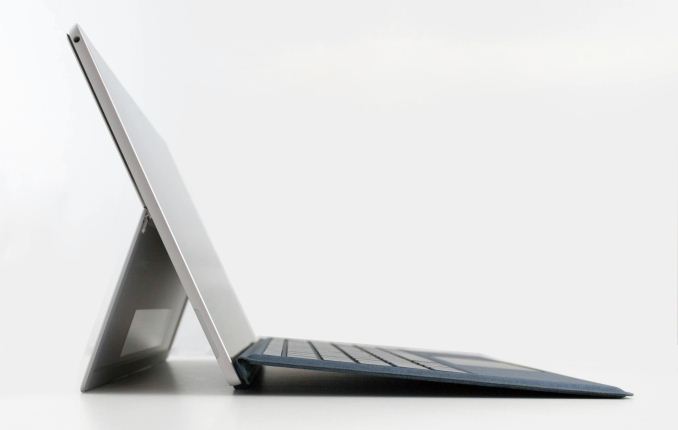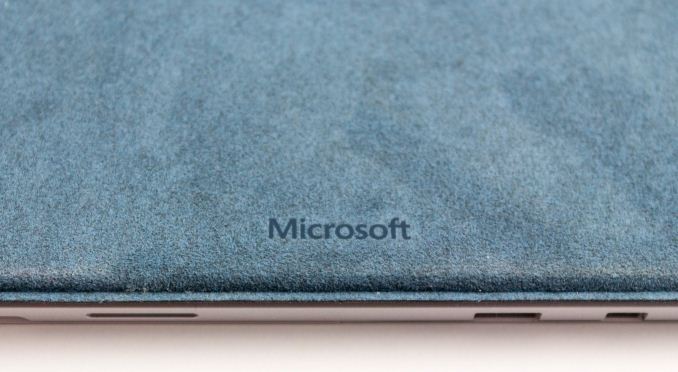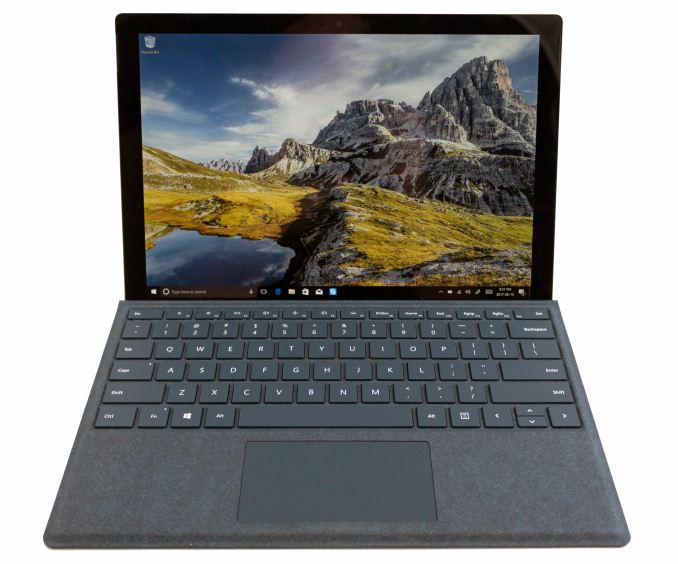The Microsoft Surface Pro (2017) Review: Evolution
by Brett Howse on June 15, 2017 9:00 AM ESTFinal Words
The Surface Pro lineup has always been one of the most powerful tablet class devices around. Microsoft is no longer marketing it as a tablet that can replace your laptop anymore though, and they’ve acknowledged that most of the customers who buy and use the Surface Pro are looking for an ultraportable laptop. That makes a lot of sense, since the Surface Pro weighs only 786 grams / 1.73 lbs for the Core i5 and i7 models, and the Signature Type Cover only adds another 310 grams / 0.68 lbs. As a complete package, it’s only 1.096 Kg / 2.41 lbs. It’s not the lightest device around, but it’s still very light and easy transport.
Packing a full 15 Watt U series Intel Core processor into such a small package has been a challenge in the past, but with improvements to both the cooling and the heat output of the CPU over the last couple of generations, it’s no longer the problem it once was. The CPU is able to run at full power in the new Surface Pro without throttling, although the new power modes will throttle it by default. This allows the Surface Pro to run almost silently for almost any task, yet still offer more processing speed than the outgoing model.
The design of the Surace Pro is mostly unchanged, if you consider the size, weight, and thickness. But the new design is softer in the hand, with rounded edges where the old models were more angular, and it is immediately noticeable when you pick it up. Surface Pro didn’t need a full redesign at all, so the small touches have done a great job without messing with what made Surface Pro so popular in the first place.
The display changes follow the same theme. It’s still the same size, and resolution, but the new display now features an “Enhanced sRGB” mode which brings a bit more vibrancy to the colors, without affecting skin tones. For color critical work, there’s still the sRGB mode, which has amazing color accuracy, but for those that are willing to sacrifice accuracy for a bit more punch, the new Surface Pro delivers that. And even in Enhanced sRGB mode, the average error level is still better than many machines on the market.
Battery life has also improved, mostly thanks to a larger capacity battery, but the new Kaby Lake chip likely helps as well. Surface Pro will always lag the best Ultrabooks in battery life, because it can’t compete on outright capacity, but Microsoft has done a great job again with platform efficiency.
The I/O port situation is not ideal, and here Microsoft seems to be taking a stand against USB-C and Thunderbolt 3, to the detriment of its customers. Offering the full-size USB port that is on there now is, without a doubt, the correct decision to make. But it seems like wasted space to offer a mini DisplayPort connecter over a USB-C port which could easily handle DisplayPort duties (and so much more). USB-C is a bit of a mess, with different ports providing different alt-mode functionality, and that will continue to be a problem, but it would have been great to see a fully capable USB-C port with Thunderbolt 3 for future connectivity. Intel has announced that they will be building more of that into their SoCs soon, so that would open the door to allowing this in future Surface Pro models without having to add extra chips on the motherboard.
Surface Pro’s accessories have always played a key role in its success, and the new Signature Type Cover with Alcantara fabric is very nice to use. Hopefully the polyurethane coating will increase durability as well. It’s available in three colors to match the Arc Mouse, and the new Surface Pen.
The Surface Pen improvements are surprisingly impressive. The existing pen on the Surface Pro 4, Book, and Studio, were all good quality digital pens, offering replaceable tips, and a fantastic traction on the display, but the new version really brings it to a new level. The sensitivity is quadrupled, from 1024 levels, to 4096, and the actuation force is decreased from 20 grams to just 9 grams, plus the new pen now supports tilt. The latency has also been reduced to just 21 ms, and from testing it out, it’s amazing how you can’t easily get the pen ahead of the ink now, where there was always a small lag before.
Microsoft didn’t need to revolutionize the Surface Pro, and rather than mess with what’s worked, they’ve continued to refine it. A softer design, a wider opening kickstand, and better accessories all bring the Surface Pro ahead of the pack again. Even after being on the market since November 2015, the Surface Pro 4 was arguably still the best product in this category, and the 2017 Surface Pro extends that lead.
Pricing makes the Surface Pro competitive, with a starting price of $799 for the Core m3 model with 4 GB of RAM and a 128 GB SSD. The base model is likely just to get people in the door though, and the Core i5 model with 8 GB of RAM and a 256 GB SSD is likely the sweet spot, although it bumps the price up to $1299. The review model, with a Core i7, 16 GB of memory, and a 512 GB SSD creeps up to $2199, and the 1TB model is $2699. These prices don’t include the keyboard cover, which starts at $129.99 for the normal version, and goes up to $159.99 for the Signature edition. Compared to the Surface Pro 4, the prices are practically identical with looking at the launch prices, although the Core m3 model is $100 less expensive. The Surface Pen used to be included though, so overall, there’s a $60 price increase for most models if you used the pen. For an Ultrabook, its entry price is right in-line with the competition.














124 Comments
View All Comments
Icehawk - Thursday, June 15, 2017 - link
Have they fixed multi-monitor output yet? I support 11 various Surface devices and they are terrible about switching modes/monitors. The stock screen's resolution is unusable for most my users with everything so tiny.gerz1219 - Thursday, June 15, 2017 - link
This is my one complaint with my Surface Book -- it gets all wonky when I plug it into the dock and drive two 1440p monitors, then disconnect it and use it as a laptop. The interface doesn't snap back to normal and I usually have to reboot to get the text rendering properly again. Sometimes the dock automatically switches the resolution properly when plugged in, and sometimes it doesn't.This seems like something that should be fixable with a simple Windows update, but I was still having issues as of the last update.
Brett Howse - Thursday, June 15, 2017 - link
They've made advances here in the last couple of Windows 10 Updates in particular. Due to the short amount of time we've had to work with the device, I've not hooked it up to an external display yet, but I can.melgross - Thursday, June 15, 2017 - link
I am so tired of reading about the success of the Surface Pro, when it's clearly been close to a failure.Consider that Microsoft sold about $4.2 billion worth of products in the Surface division during 2016. That includes Surface Pro, Surface 3, Surfacebooks, keyboards, etc. the most popular Surface Pro is the i5 256GB 8GB RAM model. Most Surface Pros are sold with the keyboard.
You can do some math. That makes the average Surface Pro sale about $1,450. Doing some very simplistic work, ignoring everything else, and pretending that every sale is a Surface Pro. We get a maximum of 2.9 million Surface Pros sold in 2016. The real numbers will be lower once Surfacebooks and Surface 3 models are subtracted out.
That's not a lot. I read in Computerworld, Information week and other places, that the biggest buyers of Surface Pro devices are IT departments, where it fits within their Microsoft based environment.
I know this isn't popular to say here, but it's straight numbers. It's not a lie. This line has never really been successful, despite the joyful writing I see about it. The reality is something else. And now, the last quarter had a 26% drop in sales for the division, so tablet retrenchment has caught up with them. That's likely one reason why Microsoft has slowed down. I doubt this has ever been profitable for them.
Brett Howse - Thursday, June 15, 2017 - link
The success is how it's created a new category of devices. It also happens to be the best device in that category. It's caused everyone in the industry to make a similar, and sometimes, identical, device, but without the build quality and polish.melgross - Thursday, June 15, 2017 - link
I'd like to know just how successful that entire category is. I never see one of the things anywhere. I've never met anyone who has one. I think there's more talk than action.soliloquist - Friday, June 16, 2017 - link
Surface Revenue:2015 over 2014 was an increase of 65%
2016 over 2015 was an increase of 13%
Given that the PC market as a whole over this time was stagnant or decreasing, for Microsoft to produce these gains is pretty significant.
Source: Microsoft 2016 Annual Report
https://www.microsoft.com/investor/reports/ar16/in...
As for the unit volume, with a price close to $1,500 (or more), it is expected that number of units sold would be significantly less than other tablets.
tipoo - Monday, June 19, 2017 - link
I'm sure it's a matter of where one lives. My city isn't that big but I still see a few Surfaces in coffee shops and airports.
amdwilliam1985 - Thursday, June 15, 2017 - link
I see most students on campus(graduate school) are either using MBA or Surface Pro 3/4 now. This says a lot, consider only a couple years ago when most people are using MBA.You're right about IT department buying them, our company has bought a few of them as test drivers. I can see us getting more as the trial has been mostly smooth so far.
Hurr Durr - Friday, June 16, 2017 - link
>selling 3 mil devices>not a success because melgross says so
Woe to Microsoft.